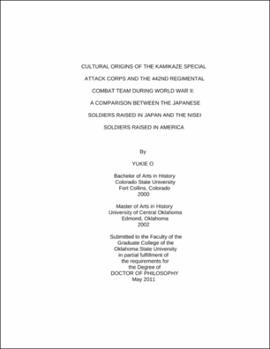| dc.contributor.advisor | Petrin, Ronald A. | |
| dc.contributor.author | O, Yukie | |
| dc.date.accessioned | 2013-11-26T08:24:18Z | |
| dc.date.available | 2013-11-26T08:24:18Z | |
| dc.date.issued | 2011-05 | |
| dc.identifier.uri | https://hdl.handle.net/11244/6784 | |
| dc.description.abstract | Scope and Method of Study: Motivated by nationalistic fervor, many young brave soldiers all over the world fought for their country at all costs during World War II. In Japan, the wartime hysteria and the desperation of the military to come up with a strategy that could stop the advance of the Allied Powers created the extraordinary suicide squad, known as Kamikaze Special Attack Corps, as an ultimate defensive weapon. In America, the 442nd Regimental Combat Team, an all-Japanese American military unit, was created as the only way for Nisei (second-generation Japanese Americans) to demonstrate their loyalty and American patriotism. Comparing the Japanese soldiers raised in Japan and the Nisei soldiers raised in America, this study, rather than focusing on their military or political significance, examines the Japanese cultural influences on the creation of such volunteer units. | |
| dc.description.abstract | Findings and Conclusions: Raised by their parents who were people of the Meiji period in Japan, both Kamikazes and Nisei soldiers upheld Japanese moral discipline whether they were in Japan or in the United States. First, they shared similar educational background. Through the Shushin (moral education) courses, they learned Japanese virtues based on the Kyoiku Chokugo (Imperial Rescript on Education). Second, they shared similar cultural values--filial piety and loyalty to the nation--that they inherited from their parents. Third, they culturally adopted Bushido as a code of conduct and a way of life for self-enlightenment. Lastly, they followed Confucianism that taught respect for parents and superiors, duty to family, and loyalty to friends. The concept of filial piety, loyalty, and patriotism played a crucial role in preparing not only the young Japanese soldiers but also the Nisei soldiers for sacrificing their lives for their countries, to which they were indebted. On these grounds I have come to the conclusion that the distinctive Japanese culture significantly influenced the creation of both unforgettable volunteer units that exposed their soldiers to exceptional dangers. | |
| dc.format | application/pdf | |
| dc.language | en_US | |
| dc.rights | Copyright is held by the author who has granted the Oklahoma State University Library the non-exclusive right to share this material in its institutional repository. Contact Digital Library Services at lib-dls@okstate.edu or 405-744-9161 for the permission policy on the use, reproduction or distribution of this material. | |
| dc.title | Cultural origins of the Kamikaze Special Attack Corps and the 442nd regimental combat team during World War II: A comparison between the Japanese soldiers raised in Japan and the Nisei soldiers raised in America | |
| dc.contributor.committeeMember | Jiang, Yonglin | |
| dc.contributor.committeeMember | Logan, Michael F. | |
| dc.contributor.committeeMember | Bracy, R. Michael | |
| dc.contributor.committeeMember | Van Delinder, Jean | |
| osu.filename | O_okstate_0664D_11340.pdf | |
| osu.accesstype | Open Access | |
| dc.type.genre | Dissertation | |
| dc.type.material | Text | |
| dc.subject.keywords | 442nd regimental combat team | |
| dc.subject.keywords | kamikaze special attack corps | |
| dc.subject.keywords | military history | |
| dc.subject.keywords | nisei | |
| dc.subject.keywords | wartime education | |
| dc.subject.keywords | world war | |
| thesis.degree.discipline | History | |
| thesis.degree.grantor | Oklahoma State University | |
